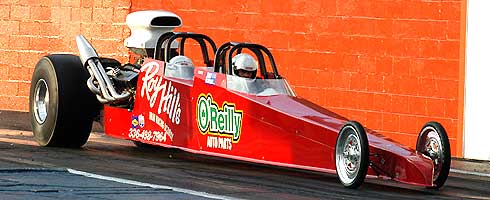|
To that end, Hill goes over the details of all the timing
beams, distances between cones, track surface, shutdown area,
even the affect of the sun’s glare on the starting tree.
He emphasizes the importance of doing a burnout and staging
the car “exactly the same every time” and says
his goal is to make us “drive like a computer.”
By that I think he means to be consistent and so attentive
to details that nothing is left to chance, but it’s
tempered by the need “to be prepared for anything, because
anything can happen at any time.”

Hill uses this special two-seater
Super Comp car to give neophytes the drag racing experience,
either in a ride-and-drive program like I went through, or
strictly as a passenger ride.
Truer words were never spoken. In a demonstration run just
a few moments later, and in his first pass in a Pro Stocker
since the spring, Hill launches the T-Bird into a huge wheelstand
after the wheelie bars were set too high and he has to feather
the throttle to bring the front end back to earth gently enough
to not even scrape the oil pan. It’s a darn good driving
job regardless of who’s in the seat, and though I know
he isn’t too happy with the wheelie bar mistake, I suspect
it’s a real confidence booster when making a comeback
from illness.
I’d be remiss in my reporting here if I didn’t
mention the fiery disposition Hill is somewhat infamous for
during his teaching sessions. Stories abound of a red-faced
Hill berating some hapless student for not sufficiently respecting
the school’s equipment, not following instructions,
or simply not “getting it” fast enough. Hill assures
us repeatedly, however, that he’s mellowed with age
and “won’t be getting on the chip,” but
we do see flashes of that ill temperament at times. He briefly
gives one student a hard time for not shaving that morning.
“Look like a professional driver,” he grouses.
To be fair, though, Hill’s criticism never comes without
reason and I think an overriding concern for safety first
is at the root of most of his tirades. As long as you learn
from them—and you can learn—it’ll work out
in the end. Tough love, I think it’s called.
Regardless, the time finally comes for my first trip down
a dragstrip. (Well, I have been in a couple of media races
before in Crown Vics borrowed from the local Ford dealership,
but that hardly counts.) To get acquainted with the sensation,
my first pass will be as a passenger in Hill’s specially-built,
two-seater dragster with him driving up front while I’m
strapped in behind with a dummy steering wheel and pedals
to play along with.
I’m assigned a racing jacket, gloves, neckbrace, and
helmet. Hill explains he’ll be in contact via radio
for this and every one of my solo attempts and I ask the question
that gets at least one rookie nailed every time: “Can
you hear me, too?” He answers my question with a question:
“Now why do you think you have anything to say that
I want to hear?!” I was afraid of that.
At most, it’s only about 70 degrees out, but with my
new uniform on, as well as being the first time I’m
tightly confined by a five-point harness, I’m already
feeling the heat. I can only imagine what it’s like
to wear a full Funny Car driver’s suit under the sun
at Phoenix, or Atlanta, or St Louis in the summer. Already
I’m gaining a little of that empathy.
Anyway, after engine start and a few last-minute instructions,
we idle up to the water box and before I know it Hill hits
the throttle and I hold my breath. He does the burnout and
the ride smoothes out just the way it does when a horse begins
to gallop. Then he lets off the gas, the tires re-assert their
grip, and that smooth gallop reverts to a bucking, violent
stop. There’s a little more insight.
We edge forward and I watch the pre-staged light come on,
then the staged light; I hear and feel the RPMs come up, yellow,
green, and we’re off! I feel the way I did the first
time I ever rode in a speedboat as a kid: excited, but just
a little scared. No, not really scared, but certainly aware
of doing something a little more dangerous than the norm,
something most people wouldn’t be doing that day.
And then it’s over. Hill is on the brakes and we’re
heading for the turnoff. I find out later we covered the eighth
in 5.81 seconds at about 121 mph, but it seemed much quicker
to me. I mean, I’ve watched a lot of eighth-mile runs
and think I have a pretty decent sense of how long a 5.8-second
pass takes. No doubt it’s quick, but when you’re
on the starting line watching a car drive away at that speed
it feels like plenty of time over that distance. In the car,
however, time feels compressed.
But that’s exactly what Hill spoke about during our
sit-down session. “I’ll make your brain work faster,”
he promised. “You’ll be able to take in more and
think about it as if it’s in slow motion. It’s
all about focus. When you get in that car you’ve got
to know where you’re going.”
|
